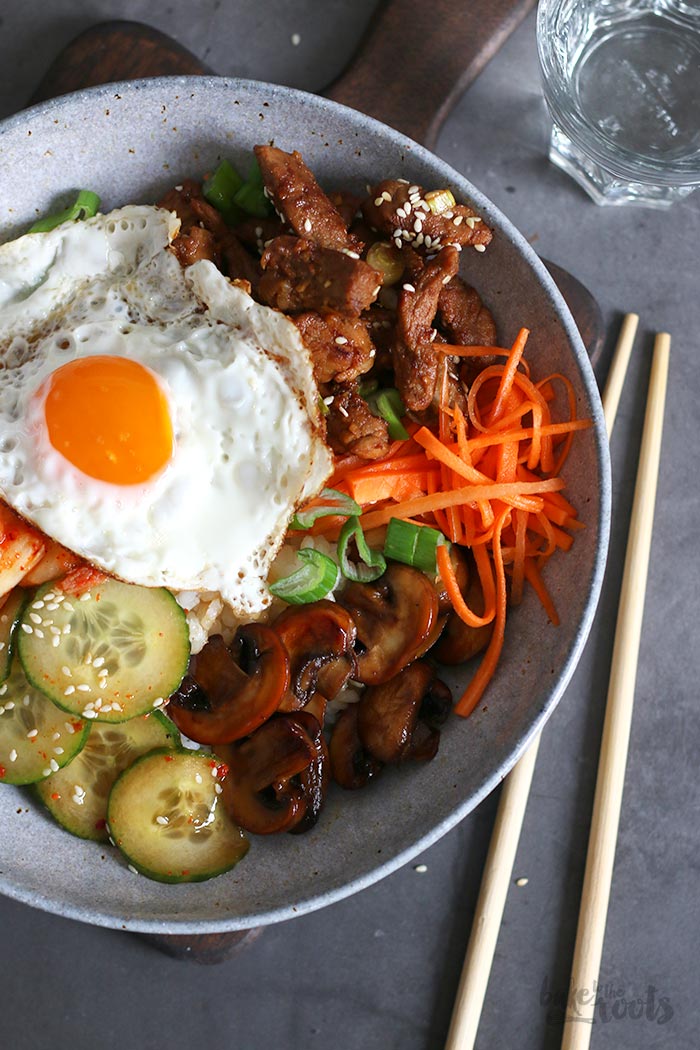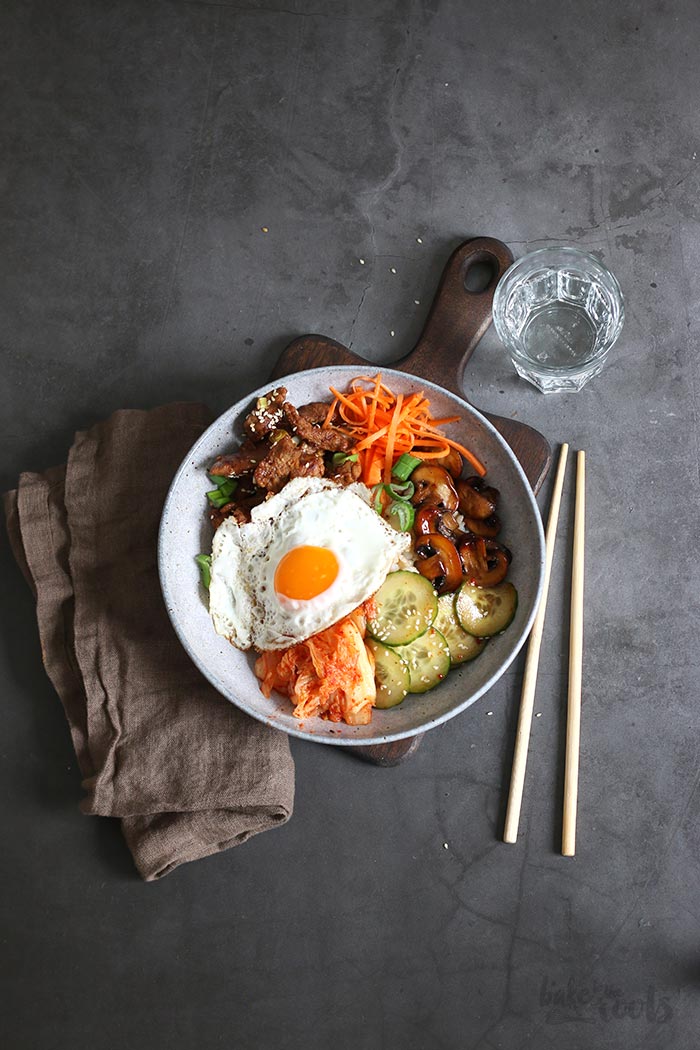Some of you probably noticed already that I am not only serving cake these days – COVID and the lockdown made it possible(or necessary?), you could say. For weeks I hardly found anybody to eat my cakes and other bakes – all friends were stuck at home and there was no office to go to and get rid of leftover cake, so I had to take a little break from baking. But I can’t just be in a kitchen and do nothing, so I decided to turn my attention to cooking… and you all have to live with that now 😜 Well… today I got a delicious dish for you l like a lot: Korean Bibimbap with pork and veggies. Simple and super tasty!

Many people probably heard of bibimbap already, but I guess not everyone has actually eaten real Bibimbap. Here in Berlin, there are quite a lot of (great) Korean restaurants, but outside the capital, the “Korean restaurant density” decreases rapidly I’d say. It’s a real pity because Korean cuisine has a lot to offer! Bibimbap is only one of many delicious dishes that are coming from Korea. Kimchi is something you probably know as well… even though that isn’t a proper “dish” – you wouldn’t eat it on its own as lunch, for example – it’s more like a side dish or part of a dish… I used that sour piled cabbage here as one of my veggie additions for the Bibimbap.

This week I would have been able to get my first “original” Bibimbap directly where it was invented/created initially… in Korea. Would have. Not going to. I think you can guess why. Some stupid pandemic made it impossible to go on a long-planned trip to Asia. Seoul would have been one stop on our trip – not only for the Bibimbap, of course, but to see and experience the Korean culture. It is really sad… but bitching about it does not help ;) The chances to plan another trip and go there in the near future are slim, but you can always hope. In the meantime we’ll just continue to do our Bibimbap ourselves and watch some documentaries… ;P
When it comes to the individual components of a Bibimbap, you are actually quite free to use what you like and want to include in the dish. We usually use sweet and spicy pickled cucumber, carrots or radishes sour plus fried mushrooms, maybe some bamboo shoots, beef or tofu. And of course, you need some Kimchi – spicy pickled and fermented cabbage. Sooo delicious!
You can get the individual ingredients in every Asia supermarket – even the already pickled Kimchi. If you don’t have such a market nearby, of course, a “normal” supermarket will do too. Most of the ingredients can be found there too if the store has a section for Asian groceries. So nothing should stand in the way of a delicious Korean dish, even if you live somewhere in a remote area of Germany ;)
INGREDIENTS / ZUTATEN
(2 servings)
For the marinated veggies:
1 piece of cucumber (2 inches), sliced
1 tbsp. sesame oil
1 1/2 tbsp. soy sauce
1 tsp. white sesame seeds
salt, pepper, chili flakes
1 small carrot, sliced finely
1 tbsp. white wine vinegar
1/2 tsp. honey
1/2 tsp. mirin
For the meat:
10.5 oz. (300g) pork fillet, in strips
2 garlic cloves, pressed
1 small piece of ginger, diced finely
2 tbsp. honey
2 tbsp. rice vinegar
1 tbsp. soy sauce
1 tsp. mirin
salt, pepper
1 spring onion
some sesame oil for frying
1 tbsp. white sesame seeds
For the rice:
5.3 oz. (150g) Shushi ice
10.2 fl. oz. (300ml) water
For the mushrooms:
3.5 oz. (100g) brown mushrooms
some sesame oil for frying
1 tbsp. soy sauce
1 tsp. honey
2 medium eggs
some sesame oil for frying
some kimchi (homemade or from the Asia store)
(2 Portionen)
Für das eingelegte Gemüse:
1 Stück Gurke (ca. 5cm), in Scheiben
1 EL Sesamöl
1 1/2 EL Sojasoße
1 TL weißer Sesam
Salz, Pfeffer, Chiliflocken
1 kl. Karotte, in feinen Streifen
1 EL Weißweinessig
1/2 TL Honig
1/2 TL Mirin
Für das Fleisch:
300g Schweinefilet, in Streifen
2 Knoblauchzehen, gepresst
1 kl. Stück Ingwer, fein gewürfelt
2 EL Honig
2 EL Reisessig
1 EL Sojasoße
1 TL Mirin
Salz, Pfeffer
1 Lauchzwiebel
etwas Sesamöl zum Anbraten
1 EL Sesam
Für den Reis:
150g Shushireis
300ml Wasser
Für die Champignons:
100g braune Champignons
etwas Sesamöl zum Anbraten
1 EL Sojasoße
1 TL Honig
2 Eier (M)
etwas Sesamöl zum Anbraten
etwas Kimchi (selbstgemacht oder aus dem Asiamarkt)

DIRECTIONS / ZUBEREITUNG
1. For the marinated veggies cut the cucumber into thin slices. Mix the sesame oil with soy sauce and white sesame seeds in a small bowl. Season with salt, pepper, and chili flakes. Add the cucumber slices to the bowl and mix everything. Set aside to marinate. Slice the carrot into very thin sticks (julienne) with a length of about 2 inches. Mix the white wine vinegar with honey, and mirin in a small bowl and marinate the julienne carrot in that mixture. Set aside.
2. Dry the pork fillet with a kitchen paper and cut into strips. Peel the garlic and press through a garlic press into a bowl. Peel the ginger and cut into very fine dices (or grate it) – add to the bowl as well. Add the honey, rice vinegar, soy sauce, and mirin and mix to combine. Season with salt and pepper. Add the meat and mix so everything is covered with the sauce. Set aside to marinate for about 15-20 minutes. Cut the spring onion into rings – separate the green parts from the white parts. The white rings will be added to the meat later and the green rings are for decorations.
3. Add the rice to a sieve and rinse with cold water until the water is not cloudy anymore. Add the water to a pot and bring to a boil. Add the rice, reduce the heat to low and cover – let the rice simmer for about 10 minutes. The water should disappear almost completely. As soon as the rice is cooked remove from the heat and let sit covered for 5-6 minutes.
4. While the rice is cooking clean the mushrooms and cut into thick slices. Heat up a frying pan or wok with some sesame oil. As soon as the oil starts smoking add the mushrooms and fry for 3-4 minutes. Deglaze with the soy sauce and honey and mix to combine. Transfer to a bowl and set aside. Clean the pan/wok with a kitchen paper.
5. Remove the meat from the marinade and let drain a bit – set the liquid to the side for later. Heat up some more sesame oil until it starts to smoke again. Add the drained meat and fry until nicely browned from all sides, then add the remaining marinade liquid and let cook until reduced to a thick glaze that covers the meat completely. Add the sesame seeds and the white rolls of the spring onion, mix and set aside.
6. Heat up some oil and fry two eggs sunny side up.
7. As soon as everything is ready to start plating – loosen the rice a bit and divide between two bowls. Add the marinated carrots, cucumber, mushrooms, and the meat on the side of the rice as well as some Kimchi. Place the fried egg on top and decorate with some of the green spring onion rolls. When served mix everything and enjoy.
1. Für das eingelegte Gemüse ein Stück Gurke (ca. 5cm) in dünne Scheiben schneiden. Sesamöl mit Sojasoße und weißem Sesam in einer kleinen Schüssel verrühren. Mit Salz, Pfeffer und Chiliflocken würzen. Die Gurkenscheiben in die Soße legen und marinieren lassen. Die Karotte in sehr feine (etwa 5cm lange) Streifen schneiden. Den Weißweinessig mit Honig und Mirin in einer kleinen Schüssel verrühren und dann die Karottenstreifen darin einlegen. Gurkenscheiben und Karottenstreifen zur Seite stellen.
2. Das Schweinefilet trockentupfen und in Streifen schneiden. Die Knoblauchzehen schälen und durch eine Knoblauchpresse in eine Schüssel drücken. Den Ingwer schälen und in sehr feine Würfel schneiden (oder fein reiben) – ebenfalls in die Schüssel geben. Den Honig, Reisessig, Sojasoße und Mirin in die Schüssel dazugeben und alles verrühren. Mit etwas Salz und Pfeffer würzen. Das Fleisch dazugeben, alles gut vermengen und dann für 15-20 Minuten marinieren lassen. Die Lauchzwiebel in Ringe schneiden – dabei den weißen und grünen Teil der Frühlingszwiebel voneinander trennen. Die weißen Ringe kommen später zum Fleisch dazu und die grünen Ringe sind für die Dekoration.
3. Den Reis in ein Sieb geben und mit kaltem Wasser abspülen, bis das Wasser klar abrinnt. Einen Topf mit dem Wasser zum Kochen bringen. Den Reis dazugeben, die Temperatur auf die niedrigste Stufe stellen und dann abgedeckt etwa 10 Minuten köcheln lassen – das Wasser sollte komplett aufgesogen worden sein. Wenn der Reis gar ist vom Herd ziehen und noch etwa 5-6 Minuten ziehen lassen.
4. Während der Reis kocht die Pilze putzen und in dicke Scheiben schneiden. Einen Wok oder Pfanne mit etwas Sesamöl erhitzen. Sobald das Öl anfängt zu rauchen die Pilze dazugeben und für 3-4 Minuten scharf anbraten. Mit Sojasoße und Honig ablöschen und vermischen. In eine kleine Schüssel umfüllen und den Wok oder die Pfanne mit einem Papiertuch auswischen und säubern.
5. Das Fleisch aus der Marinade herausholen und etwas abtropfen lassen. Marinade zur Seite stellen. Den Wok oder die Pfanne wieder mit etwas Sesamöl erhitzen. Sobald das Öl anfängt zu rauchen das abgetropfte Fleisch ohne die Flüssigkeit bei starker Hitze von allen Seiten scharf anbraten. Wenn das Fleisch schön Farbe bekommen hat und die Flüssigkeiten verkocht sind die Marinadenflüssigkeit dazugeben und alles gut verrühren, bis die Flüssigkeit eingedickt ist und das Fleisch rundum damit überzogen ist. Den Sesam und die weißen Frühlingszwiebelröllchen dazugeben, vermischen und dann zur Seite stellen.
6. In einer Pfanne etwas Öl erhitzen und zwei Eier darin anbraten.
7. Wenn der Reis und die Beilagen fertig sind, kann angerichtet werden. Den Reis mit einer Gabel oder einem Löffel etwas auflockern und auf zwei Schalen aufteilen. Am Rand der Schalen entlang die Beilagen verteilen – eingelegte Gurken, Karotten, Pilze, sowie das Fleisch und etwas Kimchi. Die Spiegeleier kommen oben drauf und dann kann man noch etwas mit den Frühlingszwiebelringen dekorieren. Wenn serviert wurde einmal alles durchmischen und dann genießen ;)

Craving more? Keep in touch on Facebook, Twitter, Instagram and Pinterest for new post updates and more. You can also contact me with any questions or inquiries!
Here is a version of the recipe you can print easily.
Print
Korean Bibimbap with Pork
- Prep Time: 00:35
- Cook Time: 00:30
- Total Time: 00:45m
- Yield: 2
- Category: Dinner
- Cuisine: Korean
Description
We love Korean food – Bibimbap with Pork is one of your favorite dishes. So good with some homemade Kimchi :D
Ingredients
Instructions
Notes
Enjoy cooking!







 I love my job, but in between I love to bake and try new things in the kitchen. A lot of my friends and colleagues encourage me to bake - for a very simple reason: they get the leftovers - and it seems they like it most of the time ;)
I love my job, but in between I love to bake and try new things in the kitchen. A lot of my friends and colleagues encourage me to bake - for a very simple reason: they get the leftovers - and it seems they like it most of the time ;) 











